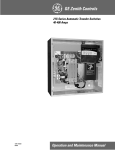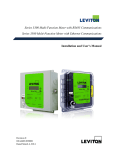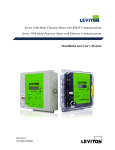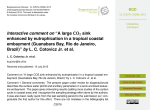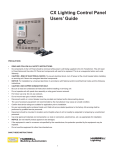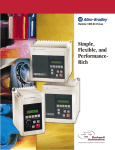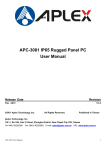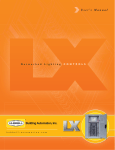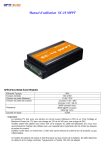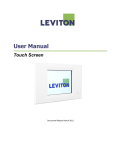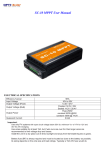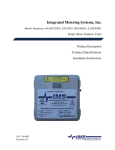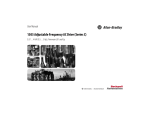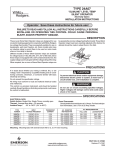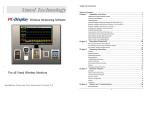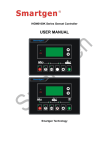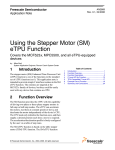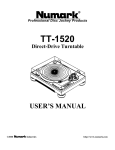Download Series 3000 User Manual and Product Features
Transcript
Series 3000 User Manual and Product Features PN: OXA3501-890000 Revision 1.0 Revision 1.0 Series 3000 User Manual and Product Features Technical Specifications 1.1 Model Number Description Figure 1: Series 3000 model number format 1. Meter Series S3 – Series 3000 meter 2. Voltage Configuration: Rated voltage 208 - 1, 2 or 3PH, 2, 3 or 4 W (120V, 208V, 120/240V): Voltage rating. 480 - 1, 2 or 3PH, 2, 3 or 4 W (277/480V): Voltage rating. 600 - 1, 2 or 3PH, 2, 3 or 4 W (347/600V): Voltage rating. 3. Enclosure R – Outdoor Surface Mount, UL4X (NEMA 4X) rated, with clear lid N – Indoor surface mount (Not suitable for outdoor use) 4. Meter Capacity: Enclosure maximum capacity 5. Number of Installed Meters 6. CT Ratings 011 – 100:0.1 021 – 200:0.1 041 – 400:0.1 081 – 800:0.1 7. Additional Options 00 – No Options 01 – Demand 05 – Grounded Delta 8. Firmware Options Leviton p2 161 – 1600:0.1 301 – 3000:0.1 501 – 5000:0.1 Revision 1.0 Series 3000 User Manual and Product Features 1.2 Serial Number Description The Series 3000 serial number format is shown below in Figure . Figure 2: Meter serial number description 1. 2. 3. 4. YY: Last two digits of the manufacturing year DDD: Day of manufacture, 1-365 or 366 A: First digit of meter serial number, alphabetic A-Z 0000: Last three digits of meter serial number, numeric 0-9 For storage and display purposes, the last five digits of the serial number are converted to a hexadecimal number. For instance, meter C3591 is stored as 0x005C27. Leviton p3 Revision 1.0 Series 3000 User Manual and Product Features Physical Description 1.3.1 Enclosures Series 3000 meters are available in two enclosures: a UL4X rated plastic enclosure for outdoor applications and a metal enclosure for indoor only use. The dimensions of the two enclosures are shown below: . Figure 2: ULType 4x Outdoor Enclosure Leviton p4 Revision 1.0 Series 3000 User Manual and Product Features Figure 3: Metal indoor use only enclosure. Leviton p5 Revision 1.0 Series 3000 User Manual and Product Features 1 Phase, 2 wire (120 V or 277 V) 1 or 2 Phase, 3 Wire (120/208, 120/240 or 277/480 V) 120VAC +/-15% 277VAC +/- 15% 120VAC +/-15% 277VAC +/- 15% 7 VA 7 VA Primary: Max Oper. Current + 10% Secondary: 0.12 A Primary: Max Oper. Current + 10% Secondary: 0.12 A 50-60 Hz 50-60 Hz 0.5 to 1.0 leading or lagging 0.5 to 1.0 leading or lagging +/- 0.5% of registration @ 1.0pf, 1% to 100% of rated current +/- 0.5% of registration @ 1.0pf, 1% to 100% of rated current +/- 0.75% of registration @ 0.5pf, 1% to 100% of rated current +/- 0.75% of registration @ 0.5pf, 1% to 100% of rated current Meter Operating Temperature -30 to +60 degrees C -30 to +60 degrees C Display Operating Temperature -20 to +50 degrees C -20 to +50 degrees C 2 2 80% 80% 14-18 AWG 12 in-lb of torque maximum 14-18 AWG 12 in-lb of torque maximum CT Terminal: Camden CTB9308 & CTB9208. 14-18 AWG 4.4 in-lb of torque maximum 14-18 AWG 4.4 in-lb of torque maximum I/O Terminal: 13-18 AWG 4.4 in-lb of torque maximum 13-18 AWG 4.4 in-lb of torque maximum Input Configurations Supply Voltage – +/- 15% due to supply voltage fluctuation Maximum Input Power Maximum Rated Current Line Frequency Power Factor Range 1 Accuracy Rated Pollution Degree 2 Rated Relative Humidity Terminal Blocks: Voltage Terminal: Molex 386344304 Dinkle/International Connector Table 1: 1PH, 2W and 1or 2 phase, 3W Series 3000 electrical specifications 1 Accuracy based on Leviton solid core current transformers (included), with 100mA secondary output. 2 Meter input burden resistance at 2 Ohm. Pollution Degree 2: Normally only non-conductive pollution occurs. Occasionally, however, a temporary conductivity caused by condensation must be expected. Leviton p6 Revision 1.0 Series 3000 User Manual and Product Features 1.3 Electrical Specifications 2Phase, 2 Wire Delta 3 Phase, 3 Wire Delta (208, 480, 600 V) 3 Phase, 4 Wire Wye (120/208 , 240/416, 277/480 or 347/600 V) Line to Line: 208VAC +/-15% 416VAC +/-15% 480VAC +/-15% 600VAC +/-15% Line to Neutral: 120VAC +/15% 277VAC +/15% 347VAC +/15% 7 VA 7 VA Primary: Max Oper. Current + 10% Secondary: 0.12 A Primary: Max Oper. Current + 10% Secondary: 0.12 A 50-60 Hz 50-60 Hz 0.5 to 1.0 leading or lagging 0.5 to 1.0 leading or lagging +/- 0.5% of registration @ 1.0pf, 1% to 100% of rated current +/- 0.5% of registration @ 1.0pf, 1% to 100% of rated current +/- 0.75% of registration @ 0.5pf, 1% to 100% of rated current +/- 0.75% of registration @ 0.5pf, 1% to 100% of rated current Meter Operating Temperature -30 to +60 degrees C -30 to +60 degrees C Display Operating Temperature -20 to +50 degrees C -20 to +50 degrees C 2000 meters maximum 2000 meters maximum Do not use on CAT IV applications. 6000V Surge Do not use on CAT IV applications. 6000V Surge 2 2 80% 80% Input Configurations Supply Voltage Maximum Input Power Maximum Rated Current Line Frequency Power Factor Range 1 Accuracy Altitude 3 Measurement CAT III - 600V Rated Pollution Degree 2 Rated Relative Humidity Terminal Blocks: See Table 1 See Table 1 See Table 1 Table 2: 2PH, 2W and 3PH, 3 or 4W Series 3000 electrical specifications 1 Accuracy based on Leviton solid core current transformers (included), with 100mA secondary output. Meter input burden resistance at 2 Ohm. 2 Pollution Degree Normally only non-conductive pollution occurs. Occasionally, however, a temporary conductivity caused by condensation must be expected. 3 Measurement category III is for measurements performed in the building installation. Leviton p7 Revision 1.0 2. Series 3000 User Manual and Product Features I/O Connections and User Display Figure 1: Series 3000 connections and display Voltage Inputs Description L1 Voltage Input, Line 1 L2 Voltage Input, Line 2 L3 Voltage Input, Line 3 N Neutral input (No connect for Delta meters) CT Inputs CT1 : X1 Current Transformer input, CT1. Colored wire of CT1 CT1 : X2 Current Transformer input, CT1. White wire of CT1 Leviton p8 Revision 1.0 Series 3000 User Manual and Product Features CT2 : X1 Current Transformer input, CT2. Colored wire of CT2 CT2 : X2 Current Transformer input, CT2. White wire of CT2 CT3 : X1 Current Transformer input, CT3. Colored wire of CT3 CT3 : X2 Current Transformer input, CT3. White wire of CT3 Outputs (Pin Number) Future use 1 Future use 2 Future use 3 Future use 4 Future use 5 Future use 6 Future use 7 Future use 8 Future use 9 Future use 10 Future use 11 Future use 12 Future use 13 Output to electromechanical kWh counter 14 Output to electromechanical kWh counter Table 3: Series 3000 I/O connections Leviton p9 Revision 1.0 Series 3000 User Manual and Product Features 3.0 Installation Instructions Please see installation instructions included for details. 4. General Metering Features 4.1 Accuracy - Factory Calibration Leviton meters are factory calibrated for compliance with ANSI C12.1. Every meter is associated with a calibrated watt-hour standard traceable to NIST. Watt-hour standards are calibrated on a yearly basis by an independent NRTL (Nationally Recognized Test Lab). 4.2 3PH 3W Delta vs. 3PH Wye operation The Series 3000 meter is compatible with both 3-phase Delta and 3-phase Wye systems. For 3-phase Delta applications, the meter is powered from Line 1 and Line 2, and the Neutral connection is left floating. For 3-phase Wye configuration, the meter is powered from Line 2 to Neutral. For information on connecting the meter, please see installation instructions. 4.3 kWh and Demand All versions of the Series 3000 meter provide kWh, maximum demand, and instantaneous power measurements on the LCD. kWh Calculations Calculations for kWh are stored in multiple registers for higher accuracy, specifically in light load situations. One register is used as a holding register and another is used as an incremental register. The incremental register is a fast ‘roll over’ register, which resets at 1000 kWh. The holding register is updated on each roll over of the incremental register. The running kWh total is a sum of the two registers. This design prevents the loss of fractional Wh during calculations and maintains kWh and demand accuracy across a wide range of loads. Display KWh is displayed in three different ways depending on the current reading: kWh Total Less than 100,000 Between 100,000 and 1,000,000 Greater than 1,000,000 Leviton p10 Digits Left of Decimal 5 6 7 Digits Right of Decimal 2 1 0 Revision 1.0 Series 3000 User Manual and Product Features KWh rolls over when it reaches 10,000,000. See section 6.3 for more display information. Maximum Demand Calculations Maximum demand (in Watts) are calculated in 15 minute blocks. Sub-interval calculation: Sub-intervals last 5 or 10 minutes, depending on the length of demand blocks. For each sub-interval, the total Wh consumption during the interval is divided by the number of accumulations during the interval to give average demand for the sub-interval. Accumulations occur approximately every second. Maximum demand calculation: After each sub-interval is finished, a new block demand is calculated. The block demand is comprised of the average of the 3 most recent subintervals compared to current value . The largest block demand since a demand reset is stored as the maximum demand. When an update of the maximum demand occurs, the new value and current date and time are saved to EEPROM. Display Maximum demand is displayed in Watts, and can range from 0.00 to 9999999. The display functions the same as kWh display, shown again below. Maximum Demand Less than 100,000 Between 100,000 and 1,000,000 Greater than 1,000,000 Digits Left of Decimal 5 6 7 Digits Right of Decimal 2 1 0 After the maximum demand value is displayed, the time and date for when the maximum demand occurred is shown on the following screens. See section 6.3 for more display information. Instantaneous Demand Instantaneous demand is a 5-point rolling average of the combined Watt usage of all three phases. Instantaneous demand can range from 0.00 to 9999999, and is displayed the same as maximum demand shown in the table above. Leviton p11 Revision 1.0 Series 3000 User Manual and Product Features 4.4 Voltage, current, and power per phase Calculations Volts, Amps, and Watts per phase are updated approximately every second. Volts and Amps are saved and displayed as root mean square (RMS) values. All values are calculated as a 5-point rolling average of the most recent samples. 4.5 Frequency Calculations Frequency information is received by monitoring a single phase, with priority order being Line 1 => Line 2 => Line 3. The frequency monitor only switches off a line when a low voltage is detected on that line. Frequency is calculated as a 5-point rolling average of the most recent samples. 4.6 Demand Reset All series 3000 meters have the capability to reset maximum demand. When maximum demand is reset, the maximum block demand and all current subinterval demands are set to zero (see section 4.3 kWh and Demand). An internal register is also incremented upon demand reset to keep a total of the times this action was taken. The register is a single byte, and rolls over at 255. How to reset the demand Key lock: Turn the key lock into the ‘on’ position for at least 5 seconds. The LCD will give a visual confirmation that the demand was reset. 4.7 Real Time Clock and Time of Use Metering Real Time Clock The Real time clock (RTC) continuously runs when power is supplied to the metering board. A battery backup is installed to maintain the RTC in power loss situations. If the battery is not in place or depleted, the RTC resets to 01/01/00 00:00:00 when power returns. The battery backup is a standard CR2025 lithium coin cell, rated at 3 V and 165 mAh. The lifetime of the battery depends on the operating temperature of the meter, as shown below in Table 4. Operating Temperature ◦ ( C) Temp < 25 25 < Temp < 60 Temp > 60 Estimated Battery Life (No external power) (Years) 3 2 1 Table 4: RTC battery backup lifetime Leviton p12 Estimated Battery Life (90% power uptime) (Years) 19 12 9 Revision 1.0 Series 3000 User Manual and Product Features For information on replacing the battery and/or setting the RTC using the communications port, please contact our Technical Support Department Toll –free at 1800-959-6004. Time of Use Metering All meter readings saved to the EEPROM are time-stamped with the current date and time of day from the RTC. The save interval is set to 15 minute intervals. Data is saved in FIFO format to keep the most recent readings in memory. For more information regarding data saving, see section 7. Leviton p13 Revision 1.0 Series 3000 User Manual and Product Features 5. Advanced Metering Features 5.1 Low Voltage Detection Diagnosis and Response The Series 3000 meter provides low line voltage monitoring capabilities. The threshold for this detection is 80% of rated voltage, and the voltage must stay below that level for approximately 20ms before the voltage drop is confirmed. When the voltage drop is confirmed, the Series 3000 meter stores the current time of the RTC and the current kWh readings. Only the most recent power loss time is saved in the EEPROM. Once the voltage returns to proper levels, the meter will again save immediately on the next voltage drop. Display When low voltage is detected on a phase, it is indicated with a simultaneous blinking of the ‘V’ and the corresponding phase letter. For more information see section 6. 5.2 Reverse Phase Indication Diagnosis and Response Series 3000 meters are designed specifically to measure energy consumption. As a consumption-only meter, it is expected that the energy flow will always be from the power grid and in the same direction across all lines. If the measured power usage on a phase is negative, the meter will report the corresponding CT as being reversed on the LCD display. Display When a reverse CT is detected, it is indicated with a simultaneous blinking of the ‘A’ and the corresponding phase letter. For more information see section 6. 5.3 Temperature Compensation An on-chip temperature sensor is used to measure the current operating temperature of the metering chip as it differs from the temperature during calibration. As the temperature increases or decreases, the meter updates the change and either speeds up or slows down to compensate for the new temperature. This leads to higher meter accuracy in all climates. Determining nominal temperature The nominal temperature for comparison is determined and stored during the initial calibration of the meter at Leviton facilities. This temperature is stored in EEPROM along with the traditional calibration variables. Temperature readings are measured to tenths of a degree Celsius. Leviton 14 Revision 1.0 Series 3000 User Manual and Product Features Temperature variation response 5. Advanced Metering Features When the temperature sensor detects an operating temperature that differs from the nominal temperature, the meter re-calculates a gain adjustment parameter, used for scaling all voltage and current inputs. 6. Liquid Crystal Display (LCD) 6.1 LCD Sections The LCD and corresponding sections are shown below in Figure 2. Figure 2: Custom LCD sections Main Numerical Display The main numerical display section indicates the numerical value of the current item. Phase Indicator and Display Indicator The phase and display indicator sections have two purposes. The phase indicator section shows the phase currently being displayed on per-phase values. The display indicator section gives information about the value on the main numerical display, such as units. The other purpose of these sections is to indicate low voltage and reverse current flow. Low Voltage Low voltage on a phase is shown by a blinking of the ‘V’ on the display indicator in conjunction with corresponding phase blinking in the phase section. For example, if low voltage is detected on phase A, the ‘V’ in the display indicator and the ‘A’ in the phase indicator will be blinking simultaneously. Reverse Current Leviton 15 Revision 1.0 Series 3000 User Manual and Product Features Reverse current is displayed in the same manner as low voltage, but instead of the ‘V’ from the phase indicator section blinking, the ‘A’ blinks, indicating a reverse energy flow. Energy Flow The energy flow section indicates the direction of energy flow (either to the grid or from the grid) using an arrow indicator. When the arrow points to right it indicates consumption (energy from the grid). When the arrow points to left it indicates production (energy to the grid). This meter is a consumption meter only, if the arrow direction points to the left, a reversed CT connection should be suspected. Refer to the installation instructions for proper CT orientation. Screen Number The screen number section is an alternate way to determine what information is currently being displayed. The screen numbers and corresponding value are shown below in Table 5. Screen Number 00 01 02 03 04 05 06 07 08 09 10 11 12 13 14 16 Displayed Value Current RTC Time Phase A Voltage Phase A Current Phase B Voltage Phase B Current Phase C Voltage Phase C Current Frequency Phase A kW Phase B kW Phase C kW Instantaneous Demand Maximum Demand Maximum Demand Time Maximum Demand Date (YY MM:DD) kWh from Grid (Consumption) Table 5: LCD screen numbers Leviton 16 Revision 1.0 Series 3000 User Manual and Product Features 6.2 Power-on Sequence When the Series 3000 meter is initially powered on it displays the following sequence of information: 1. Meter Serial Number The Meter Serial Number screen is shown below. The lower left number is the alphabetical digit from the meter serial number (from 01=A to 26=Z), and the main display shows the numerical portion of the Serial Number. For example, the image below represents meter serial number XXXXXC6149, with the X’s indicating the manufacturing day and year. See section 1.2 for more information on meter serial numbers. 2. Hardware Version The Hardware Version screen displays the word ‘Hard’ and the meter’s hardware version. Leviton 17 Revision 1.0 Series 3000 User Manual and Product Features 3. Software Version The Software Version screen displays the word “Soft’ and the meter’s software version. 4. CT Ratio The CT Ratio screen displays the meter’s programmed CT ratio. 5. Hello Screen Leviton 18 Revision 1.0 Series 3000 User Manual and Product Features 6. Diagnostics The diagnostics software performs 10 tests before the meter starts normal operation. The tests are indicated by the TEST icon and the words ‘Pass X’, where X is the test run number. 6.3 LCD Screens The following section goes over the LCD screens and how to interpret them. Note: Per phase screens and energy to grid not available on all models. Current RTC Time (00) The Current RTC Time screen displays the current time as stored in the RTC of the Series 3000 meter. The time is shown in typical HH:MM:SS format. Screen is only shown when LCD is in manual operation (see section 6.4). Factory default GMT -5 Leviton 19 Revision 1.0 Series 3000 User Manual and Product Features Phase A Voltage (01) The Phase A Voltage screen displays the voltage on Line 1 with respect to Neutral, measured in Volts. The ‘A’ from the Phase Indicator section and the ‘V’ from the Display Indicator section will be on. Phase A Current (02) The Phase A Current screen displays the current measured on Line 1 in Amps. The ‘A’ from the Phase Indicator section and the ‘A’ from the Display Indicator section will be on. Note: The energy flow arrow will point to the left if the meter has been miswired by either cross voltage inputs or reversed CT’s. Leviton 20 Revision 1.0 Series 3000 User Manual and Product Features Phase B Voltage (03) The Phase B Voltage screen displays the voltage on Line 2 with respect to Neutral, measured in Volts. The ‘B’ from the Phase Indicator section and the ‘V’ from the Display Indicator section will be on. Phase B Current (04) The Phase B Current screen displays the current measured on Line 2 in Amps. The ‘B’ from the Phase Indicator section and the ‘A’ from the Display Indicator section will be on. Phase C Voltage (05) The Phase C Voltage screen displays the voltage on Line 3 with respect to Neutral, measured in volts. The ‘C’ from the Phase Indicator section and the ‘V’ from the Display Indicator section will be on. Leviton 21 Revision 1.0 Series 3000 User Manual and Product Features Phase C Current (06) The Phase C Current screen displays the current measured on Line 3 in Amps. The ‘C’ from the Phase Indicator section and the ‘A’ from the Display Indicator section will be on. Frequency (07) The Frequency screen displays the frequency reading on the active line, usually Line 1, measured in Hertz. The active line only changes in a low voltage detection situation. If the voltage on Line 1 is low, the active line will automatically shift to Line 2. If Line 2 has low voltage, it will switch to Line 3. There is nothing displayed in the Phase Indicator section and the Display Indicator section will display ‘Hz’. Leviton 22 Revision 1.0 Series 3000 User Manual and Product Features Phase A Real Power (08) The Phase A Real Power screen displays the real power measured on Line 1 in kilowatts. The ‘A’ from the Phase Indicator section and the ‘kW’ from the Display Indicator section will be on. Phase B Real Power (09) The Phase B Real Power screen displays the real power measured on Line 2 in kilowatts. The ‘B’ from the Phase Indicator section and the ‘kW’ from the Display Indicator section will be on. . Phase C Real Power (10) The Phase C Real Power screen displays the real power measured on Line 2 in kilowatts. The ‘C’ from the Phase Indicator section and the ‘kW’ from the Display Indicator section will be on. Instantaneous Demand (11) The Instantaneous Demand screen displays the combined real power consumption of all phases. This is a net value (A+B+C demand regardless of Leviton 23 Revision 1.0 Series 3000 User Manual and Product Features energy flow direction). Nothing from the Phase Indicator section will be on, and the ‘kW’ and ‘SUM’ from the Display Indicator section will be on. Maximum Demand (12) The Maximum Demand screen displays the stored maximum demand. This is a net value. Nothing from the Phase Indicator section will be on, and the ‘kW’ and ‘MAX’ from the Display Indicator section will be on. For information on demand calculations, see section 4.3. Maximum Demand Time (13) The Maximum Demand Time screen displays the time of day that the stored maximum demand occurred. The format for the time is HH:MM:SS. Nothing from the Phase Indicator section will be on, and the ‘kW’ and ‘MAX’ from the Display Indicator section will be on. Leviton 24 Revision 1.0 Series 3000 User Manual and Product Features Maximum Demand Date (14) The Maximum Demand Date screen displays the date on which the stored maximum demand occurred. The format for the date is YY MM:DD. The image below indicates a maximum demand date of January 25, 2009. Nothing from the Phase Indicator section will be on, and the ‘kW’ and ‘MAX’ from the Display Indicator section will be on. Energy from Grid (16) The Energy from Grid screen displays the total energy consumption measured in kWh. The displayed value is shown at different resolutions depending on the magnitude of the energy consumption total (see below). Regardless of the resolution of the display, the value is always read as a typical number. In the images below, the readings are 59,340.86 kWh; 593,408.6 kWh; and 5,934,086 kWh respectively. Nothing from the Phase Indicator section is displayed, and the ‘kWh’ from the Display Indicator section will be on. The energy flow section will point to the right, indicating consumption. Digits Left of Decimal 5 6 7 Total Energy Consumption Less than 100,000 Between 100,000 and 1,000,000 Greater than 1,000,000 Leviton 25 Digits Right of Decimal 2 1 0 Revision 1.0 Series 3000 User Manual and Product Features 6.4 Controlling the LCD The LCD has two modes of operation, automatic scroll and manual scroll. Changing the Mode of Operation The LCD starts in automatic scroll mode. To change to manual mode, press and release the Scroll button once. To change back to automatic scroll, press and hold the Scroll button. Once the screen changes, release the Scroll button (this will take approx. 5 seconds). Manual Scrolling When the LCD is in manual scroll mode, press and release (do not hold long) the Scroll button once to go to the next screen available on the meter. Holding the button for too long will put the LCD back in automatic scroll mode as described above. Leviton 26 Revision 1.0 Series 3000 User Manual and Product Features 5.0 Troubleshooting FAQ FAQ Q: Can you use additional sets of current transformers (CT’s) with a submeter to accommodate more circuits? A: Yes, you can use up to three sets of CTs in parallel per meter. Just make sure you do not exceed the current rating per phase. CTs should be sized according to the rated amperage of the meter. Example: Monitoring 3, 100 amp circuits with a 400 amp meter would require the use of 400 amp CTs. Q: What is AMR equipment? A: AMR is Automatic Meter Reading equipment. This typically consists of radio transmitters, repeaters, and a collector that monitors, records, and transmits data to a Leviton Energy Manager, data concentrator, or Building/ Energy Management System. Contact Leviton for more information Q: Why do I need a third party billing service (RBC)? A: RBC’s are typically used with larger facilities that want to generate bills for the tenants. These companies will install, initialize, maintain, and monitor the meters not only for electrical usage but for trouble signals as well. Q: Why are the 100A and 200A solid core current transformers color coded (Black & white, red & white, and blue & white)? A: CT1 needs to monitor the same phase used to power the meter on line 1, CT2 needs to monitor the same phase used to power line 2, etc. Q: Can digital input/output wires be routed through the same conduit as voltage input and current sensing wires? A: No. In accordance with NEC and UL requirements, Class 2 wiring (digital inputs/outputs) must be separated from Class 1 wiring. Q: I still can’t get my meter to work, what now? A: Contact technical support via phone or on our website given in the following section. Leviton p27 Revision 1.0 Series 3000 User Manual and Product Features Contact Information Mailing Address 20497 SW Teton Avenue Tualatin, Oregon 97062 Hours Technical Support: Mon-Fri 6:00 AM-4:00 PM PST Customer Service: Mon-Fri 8:00 AM-5:00 PM PST Telephone Numbers 1-800-959-6004 Technical Support Toll-free 1-503-404-5501 Technical Support Local Portland, OR 1-503-404-5601 Technical Support Fax For Orders or General Sales Inquiries 1-800-736-6682 Customer Service Toll-free 1-503-404-5500 Customer Service Local Portland, OR 1-503-404-5594 Customer Service Fax Leviton p28




























